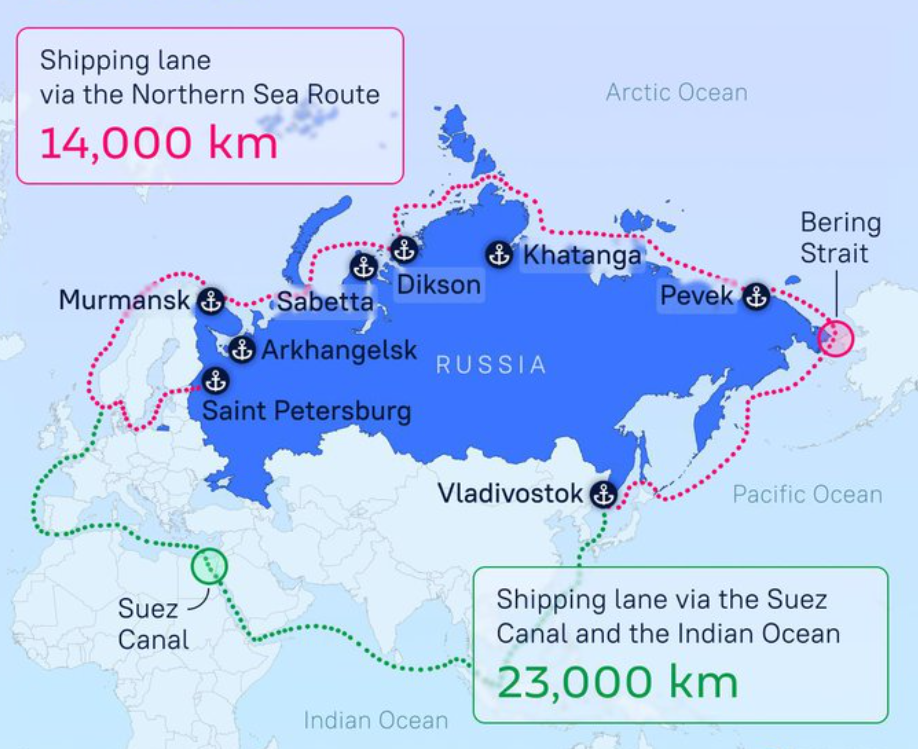
This will be interesting to pay attention to this years figures as 2023-2024 saw a 10% increase in total tonnage shipped along the Northern Sea Route. This was short of the projected target of 80 million tons so the Russians will keep increasing the fleet size to service this route. With the extra nuclear ice breakers servicing this route this should see an extra 20% this year. 200 million tons is the projected target by 2030 which may sound ambitious, but also again think it is realistic.
Every six months or so I like to have a look at what is happening with the Northern Sea Route because it is such an important trade. I should rather say it will become an important trade route due to it's limitations currently which is ice.
These days we hear very little about the Northern Sea Route compared to the pre Russia Ukraine war which takes all the headlines today. This does not mean nothing is happening in Russian waters and remains Putin's dream for Russia with regard to controlling a trade route.
Russia has significant resources in the region with oil, gas, coal and gold being the big earners for their GDP. The trade route needs to be functioning year round for Russia to benefit and not the 4 or 5 months when it is open and seen as safe enough to transit with risk or 6-7 months with high risk.
This year Chinese shipping lines have been using the route especially with the deliveries and collections from St Petersburg. This route would normally take a vessel 45 days via the Suez Canal and via the NSR less than 28 days. The NSR route will generally cut around 3 weeks off a normal vessel travelling form the east to the West and will save the company in the region of $2 million per trip.
The NSR is open for trade between the months of July through to November depending on the pack ice and even with the pack ice escorts are guided through by the nuclear powered ice breakers which Russia now has 8 in action. These are not cheap and cost vessels between $300K and $700k for an escort through the NSR route and where Putin sees huge revenue boosts for the Russian GDP. He is targeting $160 billion by 2030 and roughly 7% of their GDP being generated via this sea route.
Last year Putin targeted 80 million tons flowing through the route and they ended up with slightly under half that with 34 million tons. The container vessels used on this route have to be ice class container ships. This year Russia expects to see this number of transits rise by 1.5 x and the number of permits issued is up.
As of June this year 196 permits had been issued with 30 of these vessels being for the liquified natural gas exports. 5 of these vessels are sanctioned vessels so they will only be able to sail between Russia and China using this route and cannot use the Suez canal route.
There has been another 15 permits issued this month for Chinese vessels sailing directly to Europe which includes destination ports such as Felixstowe (UK), Rotterdam (Netherlands), Hamburg (Germany) and Gdansk (Poland). These deliveries will be 3 weeks faster than those using the other routes and more profitable for the shipping companies.
Russia is still trying to make this route into a yearly alternative and not a seasonal route. Overcoming the ice is the problem and the global warming we hear about is not changing this. It will be interesting to see if Russia does build those Nuclear Submarines to transport LNG to China or transports the LNG through the ice bound regions and offloads their load in ice free areas. Apparently just three of these submarines would transport a similar load to what a pipeline would offer. This I believe will happen or is being built currently as this would boost the Russian GDP immediately.
Posted Using INLEO